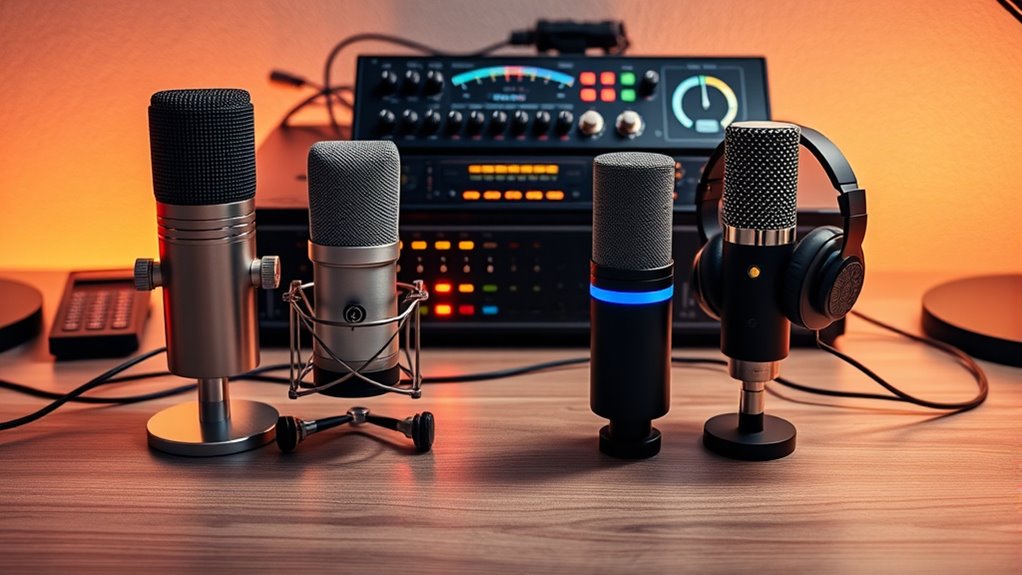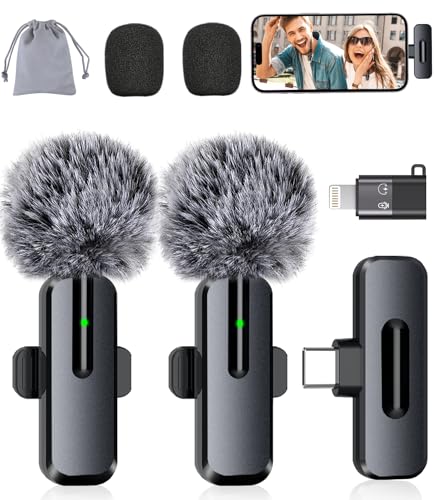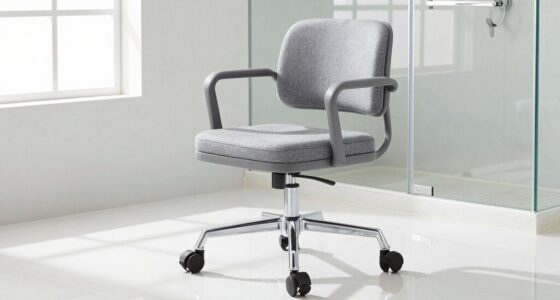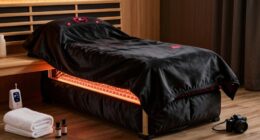If you’re looking for the best podcast microphones in 2025, I recommend options like the Blue Yeti for easy USB setup, the Shure SM7B for studio-quality sound, and the Mini Mic Pro for mobile recording. Many models offer features like noise cancellation, multiple connectivity options, and stylish designs with RGB effects. Whether you’re a beginner or pro, there’s a microphone to fit your needs and budget. Keep exploring to find the perfect match for your content.
Key Takeaways
- Look for microphones with studio-grade sound quality, noise reduction, and wide frequency response for professional podcast audio.
- Prioritize compatibility with your devices, whether USB for plug-and-play or XLR for studio setups.
- Consider features like built-in pop filters, shock mounts, and real-time monitoring to enhance recording clarity.
- Choose portable, durable models with easy setup, especially for on-the-go or remote podcasting.
- Balance your budget with options offering advanced features such as DSP effects, customizable lighting, and versatile connectivity.
Logitech Blue Yeti USB Microphone for Creators
If you’re looking for a versatile and easy-to-use microphone that delivers professional-quality sound, the Logitech Blue Yeti USB Microphone is an excellent choice for creators. Its tri-capsule array offers four pickup patterns—cardioid, omni, bidirectional, stereo—so you can record in any scenario without extra gear. The adjustable stand and pivot design help you find the perfect sound source position, while onboard controls for volume, mute, and gain give you full command. With Blue VO!CE software, you can add broadcast effects and voice modulation. Plug-and-play with a simple USB connection makes setup quick, making it ideal for streaming, podcasting, or music.
Best For: Content creators, streamers, podcasters, and musicians seeking a versatile, professional-grade microphone with easy setup and customizable sound options.
Pros:
- Offers four versatile pickup patterns for various recording scenarios without needing multiple microphones
- Equipped with onboard controls for volume, mute, and gain, plus Blue VO!CE software for broadcast effects and voice modulation
- Plug-and-play USB connectivity with a durable metal build, ensuring quick setup and long-lasting use
Cons:
- Requires Logitech G HUB software for full functionality on PC, which may add an extra step for some users
- Slightly heavy weight (about 1.55 grams) may make it less portable for mobile use
- Limited to USB compatibility, so not suitable for XLR or professional audio interfaces without adapters
Mini Mic Pro Wireless Microphone for iPhone, iPad, Android, Video Recording
The Mini Mic Pro Wireless Microphone stands out as an ideal choice for content creators who need high-quality, portable audio solutions compatible with multiple devices. It seamlessly connects to iPhone, iPad, Android devices, tablets, and laptops using USB-C and Lightning adapters, offering plug-and-play convenience without apps or Bluetooth. Its small, lightweight design—less than an ounce—makes it perfect for on-the-go recording, whether clipped onto clothing or stored in a pocket. With studio-quality sound, effective noise reduction, and wind protection accessories, it’s great for voiceovers, interviews, and outdoor videos. Plus, its rechargeable battery provides up to six hours of continuous use.
Best For: content creators and mobile videographers seeking high-quality, portable audio solutions compatible with multiple devices without the need for additional apps or Bluetooth.
Pros:
- Seamless plug-and-play connectivity via USB-C and Lightning adapters
- Compact, lightweight design for easy portability and on-the-go use
- Studio-quality sound with effective noise and wind reduction features
Cons:
- Limited to 6 hours of battery life per charge, which may require frequent recharging for long sessions
- May require adapters for certain devices, adding to setup complexity
- Potential for interference in highly crowded wireless environments
HyperX SoloCast USB Gaming Microphone
The HyperX SoloCast USB Gaming Microphone stands out as an excellent choice for streamers and podcasters who need a straightforward, high-quality microphone. Its plug-and-play setup with USB-C makes it easy to connect to PC, Mac, PS4, or PS5 without any drivers. Supporting 24-bit/96 kHz recording, it delivers studio-quality sound with a clear, detailed output. The cardioid pattern reduces background noise, while features like tap-to-mute with LED indicators add convenience during live sessions. Its flexible stand and compatibility with most mounts make positioning simple. Overall, the SoloCast offers professional sound in a user-friendly design, perfect for those seeking crisp, reliable audio.
Best For: streamers, podcasters, and content creators seeking a high-quality, easy-to-use microphone with professional sound quality.
Pros:
- Plug-and-play USB-C connection requiring no additional drivers
- Supports high-resolution 24-bit/96 kHz audio for studio-quality recordings
- Compact, flexible stand with compatibility for various mounting options
Cons:
- Fixed cardioid polar pattern limits versatility for different recording environments
- No built-in adjustable gain control or multiple pickup patterns
- May pick up some desk or environmental noise despite noise reduction features
Amazon Basics USB Condenser Microphone for Streaming and Podcasting
For podcasters seeking an easy, reliable setup, the Amazon Basics USB Condenser Microphone stands out with its plug-and-play design and versatile connectivity. Its high sensitivity and low noise, combined with a large 14mm diaphragm, deliver clear, crisp sound. The cardioid pickup pattern effectively isolates background noise, making it great for streaming and broadcasting. The 360° adjustable stand lets me easily aim the mic for ideal sound, while the built-in shock absorber reduces vibrations. Its compatibility with Windows and Mac, plus the simple USB connection, means no extra drivers are needed. The one-tap mute and compact design make it a convenient, versatile choice for any recording or streaming setup.
Best For: Podcasters, streamers, and online content creators seeking an easy-to-use, reliable microphone with excellent sound quality and minimal setup.
Pros:
- Plug-and-play USB connectivity with no driver installation required
- High sensitivity and low noise for clear, professional sound quality
- Adjustable 360° stand and built-in shock absorber for optimal positioning and vibration reduction
Cons:
- Limited to cardioid pickup pattern, which may not suit all recording environments
- Compact size may require additional accessories for certain mounting needs
- May pick up background noise if not properly positioned in noisy environments
FIFINE Gaming Microphone Set with Boom Arm and Headphones
If you’re looking for an all-in-one gaming microphone setup that’s perfect for streaming, recording, or podcasting, the FIFINE Gaming Microphone Set with Boom Arm and Headphones stands out. It offers versatile XLR and USB connectivity, making it compatible with PCs, mixers, and sound cards. The USB option is plug-and-play, so setup is quick and easy. The dynamic microphone delivers clear, low-noise audio, and the adjustable metal boom arm with elastic springs guarantees flexible positioning. The package includes a mute button, gain control, and customizable RGB lighting, creating an engaging setup. Overall, it’s a reliable, feature-rich choice for anyone seeking high-quality sound and convenience.
Best For: gamers, streamers, and content creators seeking a versatile, high-quality microphone setup with easy connectivity and customizable features.
Pros:
- Supports both USB plug-and-play and XLR connections for flexible setup options
- Includes a durable, adjustable metal boom arm with elastic springs for precise positioning
- Features customizable RGB lighting and easy-to-access controls like mute and gain knobs
Cons:
- XLR cable not included, which may require an additional purchase for XLR setup
- USB connection may be limited by the host device’s power and compatibility
- Slightly larger footprint due to included accessories, requiring adequate desk space
USB Microphone for PC Gaming, Condenser, RGB, Stand, Mute, Podcast, Streaming, Black
Gamers and streamers seeking a versatile microphone will find the USB condenser model with RGB lighting and customizable effects an excellent choice, especially since it combines professional sound quality with easy-to-use controls. It offers noise reduction, real-time voice monitoring, and three reverb modes, making it perfect for streaming, podcasts, and gaming. The built-in RGB lighting features 10 effects, which you can switch or turn off to match your setup or mood. With intuitive controls like a mute button, volume knob, and quick toggle for effects, it’s simple to use. Compatibility with Windows, Mac, PS4, PS5, and phones makes it a flexible, plug-and-play option for creators.
Best For: gamers, streamers, and content creators seeking a versatile, professional-quality USB microphone with customizable lighting and effects for streaming, podcasting, gaming, and recording.
Pros:
- Easy plug-and-play setup compatible with multiple devices including Windows, Mac, PS4, PS5, and phones.
- Built-in RGB lighting with 10 effects and adjustable modes to match your setup or mood.
- Features noise reduction, real-time monitoring, and multiple reverb modes for versatile audio quality.
Cons:
- Not compatible with Xbox consoles.
- May require additional accessories for optimal phone or mobile device use.
- Limited advanced customization options compared to professional studio microphones.
Wireless Mini Microphone for iPhone, 2 Pack Lavalier Bluetooth Mic for Video Recording
The Wireless Mini Microphone for iPhone, 2 Pack Lavalier Bluetooth Mic, stands out as an ideal choice for content creators who need high-quality, portable audio solutions. These microphones connect instantly via USB-C or Lightning adapters, requiring no apps or Bluetooth pairing, making setup quick and hassle-free. Designed for broadcast-quality sound, they deliver clear, studio-vocal clarity perfect for videos, podcasts, and live streaming. Their noise reduction features, including deadcat covers and DSP technology, ensure crisp audio outdoors or in busy environments. With a 360° rotating clip and lightweight build, they’re versatile and durable, perfect for capturing audio from any angle on the go.
Best For: content creators, vloggers, and podcasters seeking reliable, portable wireless microphones for high-quality audio recording on mobile devices.
Pros:
- Instantly connects via USB-C and Lightning without the need for apps or Bluetooth pairing, enabling quick setup.
- Equipped with noise reduction features like deadcat covers and DSP technology for clear sound outdoors and in busy environments.
- Lightweight and versatile with 360° rotating clips, making it easy to position on collars, shirts, or hats from any angle.
Cons:
- Requires 2 C batteries, which may need replacement over time.
- Limited to one channel with a frequency response of 4.8 GHz, potentially restricting multi-device use.
- Battery life of up to 16 hours may still be insufficient for extended recording sessions without replacements.
ZealSound USB Microphone for PC and Mac
For content creators seeking versatility and plug-and-play convenience, the ZealSound USB Microphone stands out as an excellent choice. It’s compatible with Windows, Mac, PS4, PS5, iPhone, iPad, Android phones, and tablets, making setup effortless with included adapters. The microphone delivers crystal-clear, balanced audio, thanks to its wide frequency response and noise-canceling features. With a professional gain knob, echo control, and latency-free live monitoring, it offers precise audio adjustments. Its sturdy design and portable size make it perfect for streaming, podcasting, or gaming on the go. Rated 4.4 stars from thousands, it’s a reliable, user-friendly option for high-quality sound.
Best For: content creators, streamers, gamers, and podcasters seeking a versatile, easy-to-use microphone compatible with multiple devices.
Pros:
- Plug-and-play setup with included adapters for seamless connection across various platforms
- High-quality audio with wide frequency response and noise-canceling features for clear voice capture
- Adjustable gain, echo control, and latency-free monitoring for precise sound customization
Cons:
- May require additional space due to its size and stand for optimal positioning
- Limited advanced features compared to professional studio microphones
- The built-in noise reduction might not eliminate all background sounds in very noisy environments
Gaming Microphone for PC with USB connection, Condenser Mic with Mute & Pop Filter, RGB Lighting, Compatible with PS4/5 & Computers
Looking to elevate your gaming and streaming setup? This gaming microphone with USB connection delivers crisp, clear sound thanks to its large 25mm condenser capsule and high 192kHz sampling rate. The cardioid pattern focuses on your voice, minimizing background noise. Its stylish gradient RGB lighting syncs with your broadcast, turning off when muted for visual feedback. Practical features include a one-touch mute, rotary volume control, and a 3.5mm headphone jack for real-time monitoring. Built with a weighted steel base and shock mount, it’s durable and vibration-resistant. Compatible with PC, PS4, PS5, and laptops, it’s perfect for gaming, streaming, or creating content.
Best For: gamers, streamers, and content creators seeking a high-quality, stylish microphone for clear voice capture and immersive broadcast visuals.
Pros:
- Crisp sound quality with a large 25mm condenser capsule and 192kHz sampling rate for detailed audio.
- Dynamic RGB lighting synchronized with broadcasts that turns off when muted, providing visual feedback.
- Durable build with weighted steel base, shock mount, and anti-splash screen for long-lasting use and vibration reduction.
Cons:
- Requires USB connection, limiting compatibility to devices with USB ports.
- RGB lighting and features may be unnecessary for users preferring minimalistic setups.
- May be bulkier or heavier compared to compact microphones, potentially affecting portability.
2 Pack Wireless Lavalier Microphone for iPhone, iPad, and Android Phone
If you’re creating content on the go and need reliable audio without the hassle of complicated setups, the Pack Wireless Lavalier Microphone is an excellent choice. It works seamlessly with iPhone, iPad, Android, Windows, and Mac devices, thanks to its plug-and-play design—no Bluetooth or apps required. The two-mic pack is perfect for interviews, dual recordings, or group vlogs. With stable transmission up to 66 feet and features like noise reduction and omnidirectional pickup, you get crisp, clear sound even outdoors. Plus, the rechargeable batteries provide up to four hours of use, making it highly practical for mobile content creators.
Best For: content creators, vloggers, and mobile journalists who need reliable, easy-to-use wireless microphones for on-the-go recording across multiple devices.
Pros:
- Plug-and-play design eliminates the need for Bluetooth pairing or app installation, ensuring quick setup.
- Stable wireless transmission up to 66 feet enables flexible outdoor and indoor shooting.
- Dual-mic setup allows for recording two speakers simultaneously, perfect for interviews and group content.
Cons:
- Battery life is limited to approximately 4 hours, which may require frequent recharging for extended shoots.
- Compatibility may require adapters for some devices, such as Type-C ports on newer Android phones.
- Omnidirectional pickup can sometimes capture ambient noise, potentially affecting sound clarity in noisy environments.
FIFINE USB/XLR Dynamic Microphone for Podcast and Streaming
The FIFINE USB/XLR Dynamic Microphone stands out as an excellent choice for streamers and podcasters who prioritize versatile connectivity and high-quality sound. It features a 50Hz-16KHz frequency response that delivers balanced, natural audio, while its cardioid design minimizes background noise for clear vocals. The microphone offers both USB plug-and-play simplicity and XLR upgrade options, making it suitable for beginners and advanced users alike. Its RGB lighting, mute button, gain control, and monitoring jack add convenience, and its durable build ensures reliability across various setups. With a 4.5-star rating and versatile features, this mic is a top pick for 2025.
Best For: content creators, streamers, and podcasters seeking versatile connectivity options and high-quality sound for both beginner and advanced setups.
Pros:
- Offers both USB plug-and-play and upgradeable XLR connections for flexible use.
- Features RGB lighting, mute button, gain control, and monitoring jack for added convenience.
- Durable design with built-in windscreen and compatibility with most mic stands.
Cons:
- RGB lighting and function keys are inactive when using XLR connection.
- XLR cable is not included, requiring an additional purchase for upgradeability.
- Slightly larger and heavier, which may be less portable for on-the-go recording.
Logitech Blue Yeti USB Microphone for Streaming and Podcasting
For content creators who need versatile, broadcast-quality audio in a compact design, the Logitech Blue Yeti USB Microphone stands out as an excellent choice. Its tri-capsule array offers four pickup patterns—cardioid, omni, bidirectional, stereo—making it adaptable for streaming, podcasts, music, or gaming. With onboard controls for headphone volume, pattern selection, mute, and mic gain, it provides full control at your fingertips. Setup is simple—plug and play. Advanced Blue VO!CE software enhances sound with vocal effects and modulation, while its HD audio and low noise guarantee crisp, clear recordings. Overall, the Blue Yeti is a reliable, user-friendly option for professional-quality audio.
Best For: content creators, streamers, podcasters, and musicians seeking professional-quality, versatile, and easy-to-use audio solutions.
Pros:
- Offers four versatile pickup patterns for various recording needs.
- Equipped with onboard controls for quick adjustments and full control over audio settings.
- Includes advanced Blue VO!CE software for enhanced sound effects and voice modulation.
Cons:
- Requires a lithium-ion battery per use, which may need frequent recharging or replacement.
- Slightly larger and heavier than some compact microphones, affecting portability.
- May be more expensive compared to basic USB microphones lacking advanced features.
USB Microphone, MAONO 192KHZ/24Bit Condenser Mic Kit
The MAONO AU-A04 USB Microphone stands out as an excellent choice for content creators seeking professional-grade sound without complex setup. It features a high-resolution 192kHz/24bit sound chipset, delivering crisp, clear audio perfect for podcasts, streaming, or voiceovers. The microphone’s flat frequency response of 30Hz-16kHz captures vocals and speech accurately, while the included accessories—boom arm, pop filter, shock mount—make setup straightforward. Its plug-and-play USB 2.0 connection works with Windows, macOS, PS4, and smartphones (with OTG). With positive reviews and a strong market presence, it’s a versatile, reliable option for anyone serious about sound quality.
Best For: content creators, streamers, and podcasters seeking professional-quality sound with easy setup and versatile compatibility.
Pros:
- High-resolution 192kHz/24bit audio for crisp, clear recordings
- Plug-and-play USB 2.0 connection compatible with multiple devices and operating systems
- Includes comprehensive accessories like a boom arm, pop filter, and shock mount for easy, professional setup
Cons:
- May require additional adapters for use with certain smartphones or devices without USB ports
- Flat frequency response (30Hz-16kHz) might be limiting for some music production needs
- Slightly bulky size could be less ideal for portable or space-constrained setups
Shure SM7B Vocal Dynamic Microphone
If you’re serious about professional-quality sound, the Shure SM7B stands out as a top choice for podcasters who need versatile, broadcast-ready audio. This studio-grade dynamic mic excels in capturing smooth, natural vocals and music with its wide-range frequency response and dynamic cartridge. Its cardioid pattern effectively rejects off-axis noise, while features like bass rolloff, presence boost, and response controls let you customize your sound. Built with durable materials, it offers excellent noise reduction through air suspension shock isolation and a built-in pop filter. The XLR connection ensures seamless integration with professional audio gear, making it a reliable, all-in-one solution for high-quality podcasting.
Best For: podcasters, streamers, and vocalists seeking professional, broadcast-quality sound with versatile sound-shaping features.
Pros:
- Wide-range frequency response for natural, smooth vocals and music
- Effective off-axis noise rejection and built-in pop filter for clean recordings
- Durable construction with professional XLR connectivity for seamless studio integration
Cons:
- Requires an audio interface or mixer with XLR input, adding to setup complexity and cost
- May need additional gain boosting in some setups due to the mic’s low output level
- Heavier and less portable compared to handheld or USB microphones
2 Pcs Wireless Lavalier Microphones for iPhone, iPad, Android with Charging Case
A standout feature of the Pcs Wireless Lavalier Microphones set is its seamless compatibility with iPhone, iPad, and Android devices, making it ideal for content creators who need a reliable, portable solution. With a simple plug-and-play setup, I just connect the lightning connector, clip the mic onto my shirt, and I’m ready to record within seconds. The built-in intelligent noise reduction and high-sensitive condenser microphone ensure crisp, natural sound even in noisy environments. The compact charging case provides up to 8 hours of use, supports stable connections up to 70 feet, and makes on-the-go recording effortless. Perfect for vlogging, interviews, or live streaming.
Best For: content creators, vloggers, and professionals needing reliable wireless audio for smartphones and tablets on the go.
Pros:
- Easy plug-and-play setup compatible with multiple devices including iPhone, iPad, and Android.
- Built-in noise reduction and high-sensitive microphone for clear audio in noisy environments.
- Compact charging case with up to 8 hours of battery life and stable 70-foot wireless range.
Cons:
- May require firmware updates for optimal performance with certain devices.
- Limited to 2 microphones per set, which might not suffice for larger group recordings.
- No mention of waterproof or weather-resistant features for outdoor use.
Factors to Consider When Choosing Microphones for Podcasting
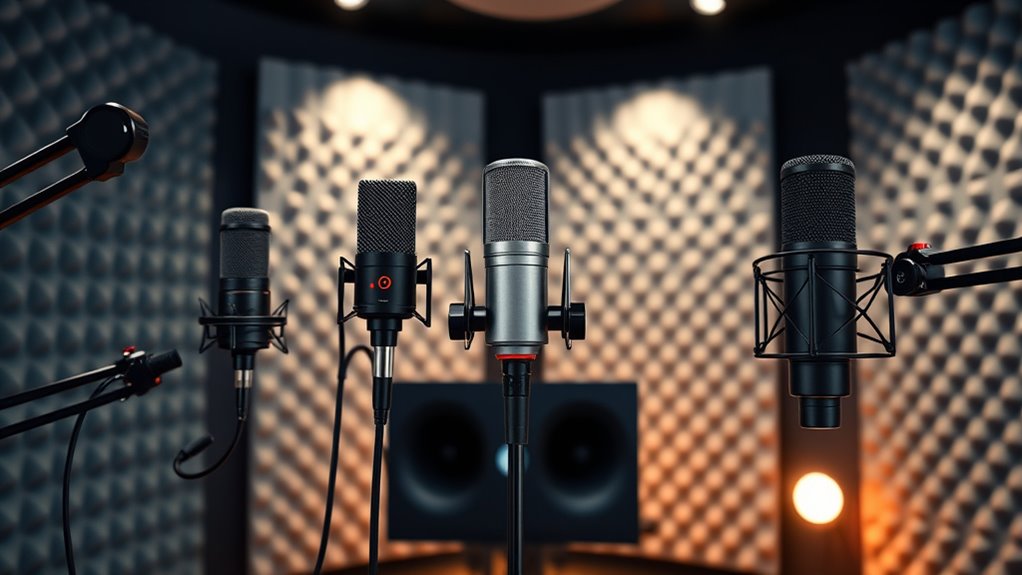
When choosing a microphone for podcasting, I consider factors like sound quality, connectivity options, and how portable the device is. It’s also important to think about my budget and whether the mic works with my existing equipment. Getting these details right guarantees I pick a mic that fits my needs perfectly.
Sound Quality Requirements
Choosing the right microphone for podcasting hinges on sound quality, which depends on several key factors. First, a wide frequency response between 20Hz and 20kHz ensures the microphone captures the full audio spectrum, delivering clarity and richness. A low noise floor, indicated by a signal-to-noise ratio above 70dB, minimizes background hiss and results in cleaner recordings. Directional pickup patterns, like cardioid or supercardioid, focus on your voice and cut out ambient noise, enhancing clarity. High sensitivity allows the microphone to pick up softer nuances, adding depth to the sound. Additionally, features such as built-in pop filters and shock mounts help reduce plosive sounds and vibrations, further refining audio quality. Prioritizing these factors guarantees your podcast sounds professional and engaging.
Connectivity Options Needed
Your microphone’s connectivity options directly impact how seamlessly it integrates into your podcasting setup. First, identify whether a USB, XLR, or wireless connection best suits your environment. USB microphones are perfect for beginners and easy setups, offering plug-and-play convenience without extra gear. XLR microphones require an audio interface, providing professional sound quality but needing more equipment. Wireless microphones offer mobility and flexibility, ideal for dynamic or on-the-go recording situations. Also, check device compatibility to ensure the connection type matches your computer, smartphone, or recording gear. Finally, consider whether you need multi-channel or mono output, depending on your preferred sound configuration. Choosing the right connectivity guarantees smooth operation and peak sound quality for your podcasting needs.
Portability and Size
Portability and size are crucial factors that can make or break a podcasting microphone, especially if you record on the go or in various locations. Smaller microphones are more portable and easier to carry, making them ideal for mobile setups. Compact designs allow for discreet use in live settings, interviews, or outdoor environments. Lightweight microphones reduce fatigue during long recording sessions, which is perfect for podcasters on the move. Many portable models include integrated stands or clip-on features, enabling quick setup and convenience. Additionally, the size of a microphone influences its compatibility with travel cases and storage options, impacting overall portability. Choosing a microphone that balances size and functionality ensures you can record anytime, anywhere without hassle.
Budget Constraints
Since budget constraints often shape our options, it’s essential to prioritize features that deliver the best value for your money. Microphones vary widely in price, from under $50 to over $300, which impacts overall affordability. With limited funds, you might need to settle for basic condenser or dynamic models that offer fewer features and lower sound quality. Cheaper microphones often lack advanced onboard controls, multi-pattern options, or software enhancements found in pricier models. However, investing a bit more can improve durability, sound clarity, and future-proof your setup as your podcasting skills grow. Setting a realistic budget helps focus on essential features like sound quality and connectivity, ensuring you choose a mic that fits both your needs and financial situation without sacrificing too much quality.
Compatibility With Devices
Choosing the right microphone involves more than just sound quality; compatibility with your device is key. First, make sure the microphone works with your operating system—whether you’re on Windows, Mac, iOS, or Android. Check its connection type—USB, XLR, 3.5mm jack, or wireless—and confirm your device supports it. Some mics need adapters like USB-C or Lightning, so ensure you have those if necessary. It’s also important to verify that the microphone’s drivers or software are compatible with your system to access all features. Finally, consider whether the connection is plug-and-play or requires extra hardware or software. Confirming compatibility saves you setup headaches and guarantees your microphone functions seamlessly for your podcasting needs.
Additional Features and Controls
When selecting a microphone for podcasting, paying attention to additional features and controls can make a significant difference in your recording experience. Features like mute buttons, gain controls, and monitoring options give you better control during recording or live sessions, helping you make quick adjustments without hassle. Built-in audio effects such as reverb or voice modulation can enhance sound quality and add a unique flair to your podcasts. LED indicators for mute status or signal strength provide visual cues, preventing accidental recordings or audio issues. Adjustable volume knobs and customizable lighting can personalize your setup for comfort and aesthetics. Plus, accessories like pop filters, shock mounts, and windshields can drastically improve sound clarity by reducing plosives, vibrations, and background noise.
Frequently Asked Questions
How Do Microphone Polar Patterns Affect Podcast Sound Quality?
Microphone polar patterns greatly influence my podcast sound quality by determining how much sound from different directions is captured. I prefer cardioid patterns because they focus on my voice while minimizing background noise, making my recordings clearer. Omnidirectional picks up sound from all directions, which can be useful in group settings but may introduce unwanted noise. Choosing the right pattern helps me get crisp, professional-sounding episodes.
What Is the Optimal Sample Rate and Bit Depth for Podcast Recording?
For podcast recording, I recommend a sample rate of 44.1 kHz or 48 kHz and a bit depth of 16 or 24 bits. Think of it as capturing the full color palette of your voice—higher rates and depths give richer detail, but these settings balance quality and file size. I find 48 kHz and 24-bit strike the perfect harmony for professional sound without overloading your storage.
How Does Microphone Placement Influence Audio Clarity and Background Noise?
Microphone placement is key to clear audio and minimizing background noise. I keep the mic about 6-12 inches from my mouth, slightly off to the side to avoid plosive sounds. This distance helps capture my voice clearly while reducing room echoes and ambient noise. I also use a pop filter and position the mic away from noise sources, which makes my recordings sound professional and focused.
Are There Specific Microphones Better Suited for Remote Versus In-Studio Podcasts?
Think of microphones as musical instruments; some are better suited for remote gigs, while others shine in studio settings. For remote podcasts, I recommend dynamic mics like the Shure SM58, which cut through noise like a lighthouse in fog. In-studio, condenser mics such as the Audio-Technica AT4040 capture every nuance, like a painter with a fine brush. Choosing the right mic depends on your environment and sound goals.
What Maintenance Tips Ensure Longevity and Consistent Performance of Podcast Microphones?
To keep my podcast microphones in top shape, I regularly clean the capsules with a soft, dry cloth and use a gentle brush to remove dust from ports. I also keep them in a protective case when not in use and avoid extreme temperatures. Additionally, I check cables and connectors for damage, and always power down before unplugging. Consistent care guarantees my microphones sound clear and last longer.
Conclusion
So, which microphone will truly elevate your podcasting game? The right choice depends on your style, setup, and goals—there’s more than one secret to perfect sound. I’ve shared some top picks, but the real magic happens when you find that perfect fit for you. Ready to turn up the volume and make your voice heard? The future of your podcasting journey is just a microphone away—are you ready to take that leap?
